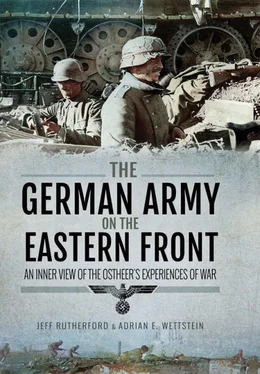III) Balkan campaign
[…] The total losses which occurred during the Balkan campaign were not covered by replacements, so that the number of missing vehicles has again increased.
IV) Refreshing by the German Liaison Command Bucharest
To discuss the question of refreshing and other requirements for the division’s equipment, the divisional quartermaster was ordered to the General Army Office and to the General Quartermaster in Berlin. […] While the allocation of a second motor vehicle workshop platoon and all-terrain vehicles was rejected, 3 medium trucks were obtained from the Liaison Command and allocated to the horse-drawn bakery company 235. Despite numerous requests and personal visits, the division received only one of the already allocated and supplied trucks. […] During the period of refreshment, the infantry anti-tank companies formed 5cm ATG platoons. On the whole, it was necessary to make 6 5cm ATG and 6 ammunition trailers mobile. For this purpose, the allocation of 12 1.5 ton trucks A-Type or 12 motor vehicles 69 or 12 medium all-terrain passenger cars was requested at the Liaison Command. An allocation of special vehicles did not occur again. Just to make the guns mobile, 3 commercial medium trucks were allocated to the division. The remaining 9 trucks had to be extracted from the handed over 3.7cm ATG platoons. Since those old light trucks were quite inappropriate for towing the heavy guns, there had to be an exchange for medium trucks inside the division, which were missing from other positions.
In addition to constant telephone communication and continuous reports and requests, repeated personal visits were undertaken relating to the period of refreshment, including those on 5.4., 29.4., 10.5., 30.5., 17.6., and 27.6. by the divisional quartermaster and the Divisional Engineer with the Quartermaster and the motor vehicle administrator of the Liaison Command. […] Among other things, the Chief of the General Staff of the 11th Army remarked: ‘It will be naturally impossible that the division goes into the Eastern war with such a motor vehicle stock.’ […] The Corps and Army could not help materially, since the Army depots were in the process of being built up and closed until the beginning of the Eastern campaign.
Despite the serious efforts of all superior commands, the Liaison Command responsible for the division’s refreshment did not succeed in compensating for the losses of the Balkan campaigns, not to mention the large shortage of vehicles. All in all, the refreshment brought the division an increase in motor vehicles of 8 motorcycles, 9 passenger cars and 11 trucks (including an additional allocation of 3 trucks for the 5cm ATGs and 3 trucks for the bakery company 235) up until the beginning of the Eastern campaign. During the deployment for the Eastern Campaign, the division lacked the following vehicles: 32 motorcycles, 7 passenger cars, 12 trucks, 1 bus, 9 special vehicles, 2 motor ambulances.
While the time-delay effect of the Balkan campaign on Barbarossa is much discussed, it is clear that this operation had a negative effect on logistics. This included significantly more wear on the vehicles than on average, which only increased the gaps in vehicle stocks. Furthermore, the diversion of 15 divisions to the Balkans from the deployment to the east caused much friction and delay for other transports. Units that had participated in the Balkan campaign should have been refreshed in May and June 1941 as a priority but, as the report shows, this was not the case. Even more problematic for the upcoming campaign was the lack of all-terrain vehicles even for combat units such as the ATG platoons.
V) Eastern Campaign
1) Deployment in the bridgehead Sculeni, losses due to enemy fire.
In addition to high losses in men and material, the division’s first deployment in the Sculeni bridgehead already also brought the division heavy losses in vehicles, in particular by strong artillery bombardment and aerial bombing, which also affected the rear sections in Jassy. Already the division has lost 30 motorcycles, 6 passenger cars, 17 trucks and 1 motor ambulance from 22.6. to 2.7. just through enemy fire. Up to this point, all special requests after losses were directed to the XXXth Army Corps, which did not appear to be promising. Order [of the] XXXth Army Corps motor vehicle officer of 30.6.41 reads as follows: ‘The replacement of lost motor vehicles is only to be expected if the total losses have reached more than 10% of the division’s motor vehicle authorized strength. It is therefore asked to refrain from individual requests, but rather to limit to [filling] out the required reports of vehicles falling out. The difficult motor vehicle situation at the 198th Infantry Division is moreover known to the corps command. If losses exceed 10% of the authorized strength, a fully filled out Form 6 is requested, indicating the distribution of the losses among individual units and any types of unique vehicles lost. Everything has been done by the corps command to help the division.’ At this time, the number of missing motor vehicles already amounted to 157 motor vehicles from an authorized motor vehicle strength of 1,006, i.e. 16%. Despite this severe weakening of the motor vehicle stock, no allocations of any importance took place, even the more so as the allocations from the normal channels of supply did not show any increase corresponding to the losses.
2) Private acquisition of motor vehicles
In a meeting of the commanding general of the XXXth Army Corps with the divisional commanders, the latter agreed to accept the private purchase of motor vehicles, in order to compensate for the entirely inadequate replenishment and to make the division with its motor vehicle inventory operationally ready for the war in the East. Forced by the need and the will to maintain the division’s operational readiness, private car purchases in Romania were initiated. As a result, by the middle of September 1941, the division was able to provide its motor vehicles stock with 54 motorcycles, 3 sidecar motorcycles, 17 passenger cars and 21 trucks. On order [of] Eleventh Army on 12.9., car sales in Romania had to be discontinued again.
Marching into the Soviet Union with an under-strength, partly worn-out motor vehicle park that in many cases did not fulfil demands such as all-terrain ability or cargo loading capacities, the division’s high losses right from the beginning of the invasion were not surprising. Losses reached the aforementioned 16 per cent of the stock only two weeks into the campaign, an ominous foreshadowing of the upcoming months. Such losses reduced both units’ mobility and their supply capacities. It is then no surprise that German units tried desperately to fill the increasing gaps in motor transport by any means, including buying vehicles on the Romanian private market. Most of these vehicles were used despite not being fit for cross-country operations. Receiving spare parts was also difficult, so the breakdown and falling out of these vehicles was only a matter of time.
3) The impact of road conditions and the use of repair services
Constantly deployed at the front, the division had to march along horrible ‘roads’, due to periodic precipitation, during the battles in Bessarabia and Ukraine. In total, about 1,700km were travelled in modest stretches to the local area, which had to be driven mainly in low gears. This resulted in very considerable wear for the entire chassis, but especially in the steering and suspension and, what is more, in the engine itself, which had a significant increase in oil consumption and a decrease in the performance. Over time, the heavy stress on the suspension– quite apart from numerous spring bridges – caused a considerable decrease in the load-bearing capacity of the trucks. As a result of the continually increasing breakdowns, it was necessary to establish numerous vehicle collection points, which inevitably became later operating sites for the 235th workshop company. With the increase in vehicle breakdowns and the resulting number of vehicle collection points, the fact that the 235th workshop company only had one vehicle workshop platoon and thus cannot be deployed with one platoon advancing while the other works is again and again decisively disadvantageous. This resulted in long towing routes to the vehicle collection points, with no tracked vehicles available to surmount this problem. Burdened with such orders, the troops and the workshop company’s heavy commercial vehicles were exposed to extreme wear and tear in the prevailing road conditions. Maintenance work was further complicated by the circumstance that, on the one hand, there were no workshops for the maintenance of motor vehicles in the country itself, and, on the other hand, the troops did not have any scheduled repairs. This deficiency had to be remedied to a certain extent with the help of makeshift repair vehicles, which decreased the tonnage available for use.
Читать дальше






![John Stieber - Against the Odds - Survival on the Russian Front 1944-1945 [2nd Edition]](/books/405234/john-stieber-against-the-odds-survival-on-the-russian-front-1944-1945-2nd-edition-thumb.webp)





